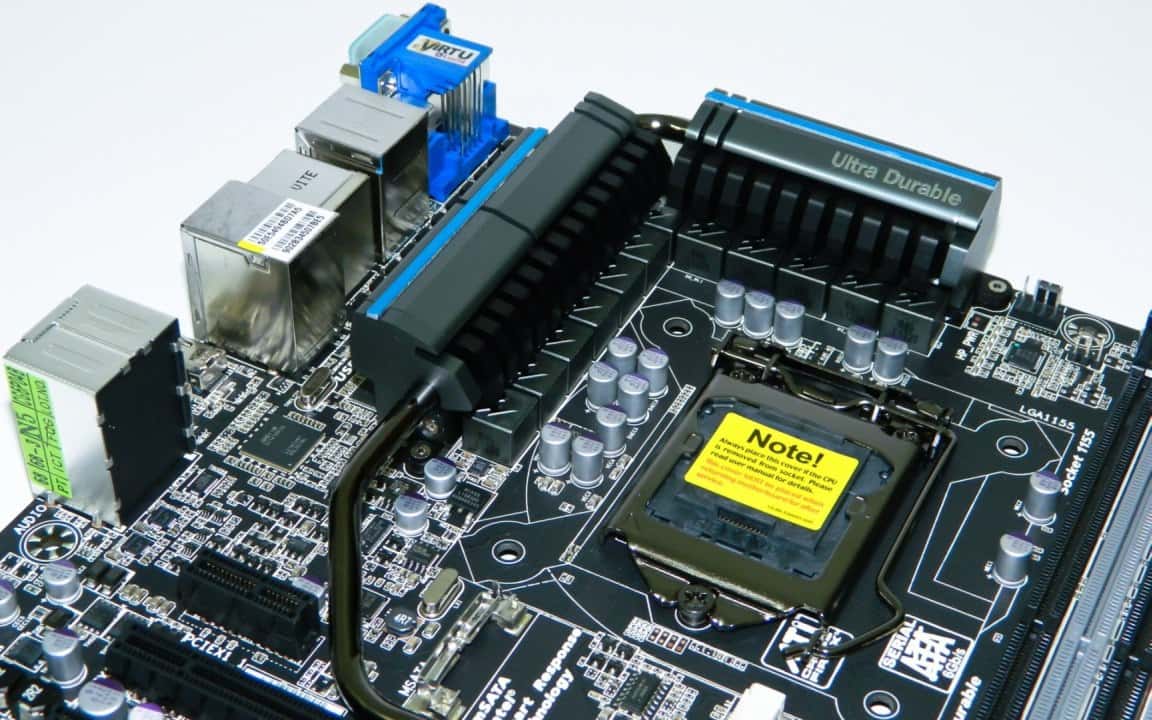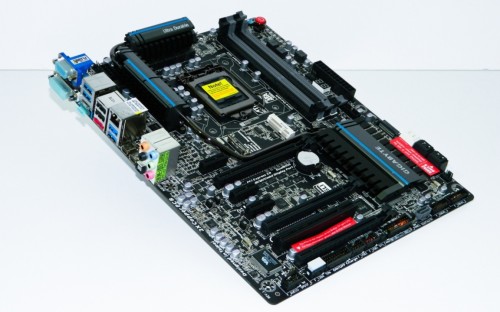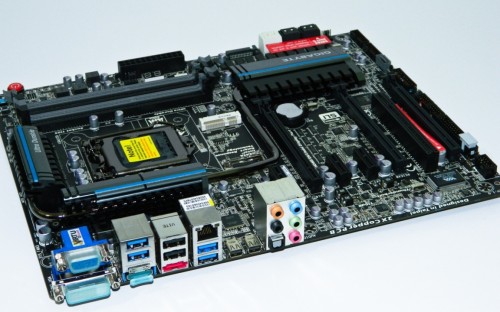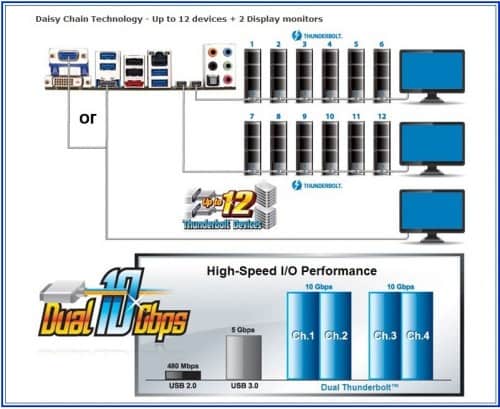GIGABYTE has been slowly refining their Z77 series and have added a couple new features that you’ll want to know about. For example, the new revisions now feature their Ultra Durable 5 technology which builds even more longevity into their boards and Thunderbolt (formerly LightPeak) connectivity. We want to know how these new features aid performance and most importantly, who benefits most from the new features. Join us for a closer look at the new GA-Z77X-UP5-TH Motherboard. from GIGABYTE.
Features and Specifications
Ultra Durable 5 is very much like the Ultra Durable technologies that came before it. You’ll find their “2X” or 2 ounce copper PCB but with enhancements this time around as well as new IR3550 PowIRstage® ICs from International Rectifier. New high current Ferrite Core Chokes rated up to 60 Amps have also been implemented while much needed digital power voltage regulation has also been added. The benefits of these technologies are less power loss and greater efficiency which results in less heat generated by the components supporting the CPU.
Intel Thunderbolt (formerly known as LightPeak) rounds off the latest feature updates. The GA-Z77X-UP5-TH comes with dual Thunderbolt ports as well as PLX 8605 controllers which ensure maximum transfer bandwidth whether being used for storage or displays/monitors. While the maximum transfer rate is 10Gbps, we’ve seen linked devices transferring 800MB/s for immensely flawless video play back over multiple displays. Unfortunately, there are very few if any Thunderbolt devices available and it’s going to be some time before we see more. Nonetheless, GIGABYTE has looked towards the future with not only one, but two of these ports, which is fairly uncommon to see.
Other than these two notable updates, the board has every extra feature their Z77 series features including mini-SATA all the way up to Lucid MVP and Intel Smart Response. For more detailed specs on the GA-Z77X-UP5-TH or the GA-Z77X-UD5H Series motherboards, head over to GIGABYTE’s website.
Retail price of the GA-Z77X-UP5-TH is in the neighbourhood of $249.99 US. A lower cost “UP4” version is also available with Thunderbolt, but some feature downgrades for around $179.99 US.
What’s In The Box?
Like the UD5-WiFi which is far more common, the accessories are almost identical. The bundle includes six SATA cables, extra USB 3.0 3.5″ front panel ports, matching IO shield, usual manuals and GIGABYTE stickers. Two black antennae are also include to support the Atheros AR5B22 WiFi card (GC-WB300D). The Atheros card has full on support wireless B/G/N networking and good transmitting potential. It’s good to see bolt-on antennae. Too bad they aren’t magnetized.
A Quick Look at the GA-Z77X-UP5-TH
The UD5 series and UP5 boards have extremely similar layout and button placement. However there are specially marked new chokes around the CPU socket and driver MOSFETs underneath the heat sinks with the heat pipe running through them. These components are the heart of the digital voltage regulation. There are also some new IOQ controllers below the memory slots to keep bandwidth moving.
Moving to the back IO ports of the UD5 and UP5, you can see the obvious IO feature changes. A display port, two red USB combo ports, a Firewire port, and one analog audio port had to be eliminated to provide two tiny, but bandwidth abundant, Thunderbolt ports. Honestly, the connectivity will eventually pay off once all the connectivity possibilities are finally realized.
Let’s see how this board performs in comparison to the Z77 boards we’ve racked up to date.
Test System Setup
The same motherboards from our world famous INTEL Z77 roundup were included for comparison. While some of the boards have new BIOS that could improve overclocking, our Ivy Bridge chip doesn’t go any higher than it has before most likely due to well publicized poor TIM or thermal performance of the chip, despite the die shrink.
- Processor: Intel Core i7-3770K Ivy Bridge
- Motherboard 1: GIGABYTE GA-Z77X-UP5-TH (as tested)
- Motherboards from Z77 Roundup
- Memory: Kingston HyperX Genesis 2x4GB 1600MHz DDR3
- Memory OC: Kingston HyperX Genesis 2x4GB 2800MHz DDR3
- Graphics: Two MSI GTX 560 Ti TwinFrozr II (SLI)
- Power: Antec High Current Pro 1000 Watt (HPC-1000)
- Storage: Kingston HyperX 120GB SSD
- OS: Windows 7 Pro 64-bit (SP1)
- CPU Cooling: NZXT. HAVIK 140
- NVIDIA 301.42 Video Drivers
Thunderbolt devices are very rare at the moment but we will return later with a comprehensive test of the true Thunderbolt performance of select boards on the market. It’s possible that manufacturers are holding off in light of the upcoming Intel chipset supporting Ivy Bridge-E so hopefully we see more options in the very near future.
Unfortunately, this means we were unable to get our own Thunderbolt devices to conduct our own detailed tests. We have no doubt that the Thunderbolt ports work but we can’t tell you how well at this point so make sure you keep checking back with us.
Is the Ultra Durable 5 BIOS and Overclocking Better?
Overclocking the UP5 was a bit easier than the UD3H and UD4 boards. The BIOS interface continues to be a little rough in spite of the cool 3D graphics though and we hope that GIGABYTE continues to refine it. What we notice most is lack of smoothness and continuity with mouse function currently.
At the end of the day, our Core i7-3770K Ivy Bridge processor sample heated up to high heaven once hitting 4.9GHz with 1.41 volts. I couldn’t get the memory frequency to 2800MHz due to the processor’s IMC, but I did manage 2600MHz. On the plus side, the BIOS overclocking presets and Easy Tune 6 offered smoother and more successful overclocking results on the UP5.
Do keep in mind that your overclocking results will vary given the variables in wafer fabrication and your choice of memory and other components.
Examining the Ultra Durable 5 Digital Power
The UP5’s new digital VRM should theoretically mean more efficient power consumption and cooler VREG components especially around the CPU socket. The UP5 was monitored under a thermal camera while running Furmark and Prime95 at 100% load for 45 minutes. Power consumption was measured while idle and at load as well. The key area we’re focusing on are the components to the left and above of the CPU cooler.
The colors pretty much say it all on the UP5. But for those that want numbers, the VREG heat sink measured 30C and the chokes around the socket reached 38C. The ASUS P8Z77-V Deluxe’s heat sink reached 52C and chokes topped out at 54C. So overall, GIGABYTE’s claims of a cooler running board are definitely true. But what about power consumption?
The GA-Z77X-UP5 TH Power Consumption and Quality Control
The UP5 consumed a meager 51 watts when idle and 288 watts at load. The ASUS P8Z77-V Deluxe consumed as little as 92 watts at idle and 285 watts at load. It appears that the two digitally controlled platforms manage well with the Deluxe doing a slightly better job on the average at load. For low power idling, the UP5 does a great job and should, in theory, save you more on your power bill in the long run as systems aren’t usually run at 100% all the time.
During the entire testing process, the board was monitored for noise emissions, EMF, and unusual heat issues which is all part of the exclusive Quality Control Initiative at Futurelooks. What I have observed throughout all Z77 testing is that the ASUS boards have consistently provided the quietest boards. GIGABYTE has been quiet except when running fully loaded SLI tests where some random component noise can just be heard.
However, the UP5 provided absolutely no VREG, PCIE, or component noise at any time during our load testing. This platform was completely silent and will satisfy silent system integrators.
Now that we’ve looked at how some of the newest features perform in some aspects, let’s get to the most important aspect of performance which is how they perform in benchmarks!
Benchmark Notes
Benchmarks are important mostly so that we are sure the board (or any board for that matter) meets certain performance requirements which is reflective of the quality of the product, and in some aspects, user experience. We’re running benchmarks for CPU, graphics and IO (USB/SATA) to compare performance and to ensure that everything just works.
Keep in mind that motherboard tuning in the BIOS and any component enhancements can improve system performance and user experience as evident in any of the reviews you’ve read from us. And as a result, you’ll see those tuning effects translated into better numbers. Let’s get cracking!
Cinebench R11.5
What we wanted to know is whether or not the new digital VRM can maintain solid Intel Turbo performance through improved transient response. We’ve seen respectably solid transient performance from most of ASUS Z77 channel boards which is why they seem to be just a bit more aggressive than the rest of the field overall. Cinebench is great for answering this question.
It would appear that the UP5 isn’t so aggressive after all. After discussing this further with industry sources and GIGABYTE, it appears the reason for the slightly slower multi-core score apparently has to do with the Thunderbolt feature which is very frequency sensitive on the Bus. Still, the stock score isn’t bad and overclocking proved to be quite fast not to mention easier to maintain in GIGABYTE’s latest power component implementation.
PCMark7
Again, PCMark7 performance was just a bit lower. Could it truly be the Thunderbolt holding things back? Will it effect every other performance aspect of the board? I kept going and find out.
Graysky x264 Benchmark 4.0
Well, the processor has no problem taking care of transcoding business in the Graysky benchmark. The UP5 was bested only by the very strong ASUS ROG GENE which features a very aggressive VRM as well as an mATX form factor.
7-Zip
Here, the compression test shows it to be comparable to all the rest. It’s not bad per say and not the slowest to finish the benchmark. Future BIOS tuning could help overall. But let’s keep going and see if it can still game.
Graphics Benchmarks
We don’t need to run too many game benchmarks to know if a motherboard is up to the task of supporting the peripherals. Aliens vs Predator, Metro 2033, and Batman Arkham City are three serious DirectX11 tessellated titles designed to answer any performance questions.
As you can see, the UP5 will let you game just fine. Frame rates are very close all around mainly since the graphics card or cards are doing 90% of the work. If you’re planning on doing some DX11 gaming, you’ll be perfectly happy with the results and have your Thunderbolt ports too.
Now that we’ve covered application performance, let’s test the rest of the hardware.
IO Performance
These connective features are often over looked by many engineers. Here, I look for any SATA, USB, or other IO port connectivity issues. Like all Z77 boards, the UP5 board and Windows drivers don’t always detect freshly connected SATA devices even when using AHCI and hardware detection. Sometimes the BIOS only sees one device when two devices are simultaneously connected to the black SATA ports. Connecting one at a time makes it easy. Also, a quick reboot usually resolves the issue.
The UP5 utilizes the Z77 chipset for USB 3.0 function and not the VIA VL800 controller like the UD3H. The PCH is a bit slower in that respect. The ASUS boards continue to provide the fastest USB 3.0 performance thanks to the Turbo and Boost feature.
As we have stated, we unfortunately could not locate any Thunderbolt devices that would give us the results we needed to give a good idea of performance. We’ll have revisit this once manufacturers provide a more thorough variety of solutions. If the Thunderbolt port is as sensitive as we’ve heard, the tests should reveal who’s implementing controllers right and wrong.
Network Performance
It’s pretty uneventful here. The UP5 doesn’t really come with any extra networking software or reveals any tuning related to networking performance. But it does score relatively well with the onboard network controller plus the bundled and very useful WiFi PCIE card. The connectors are of a ring nut design so they make very good contact with the antennae.
Audio Performance
Testing revealed the board to be good overall as far as integrated audio is concerned. Frequency response was less than admirable at 50% volume yet was better if volume wasn’t high. One of the features the GIGABYTE boards have long shown is the 110dB audio. Unfortunately, it isn’t “loss less” and does flatten out at higher volumes. Regular gamers and media users will find it to be sufficient while avid gamers will want something a bit more sinister like the ASUS Xonar series or Creative Labs cards.
Final Thoughts
When I first looked at GIGABYTE’s new Ultra Durable 5 technology, it was hard to know exactly how or if it would affect motherboard performance or even benefit the platform in some other benign way. Unless you’re some what aware of how digital VRM works, you probably wouldn’t know it offers conservative power consumption, cooler operations, extended component life, or if it could maintain higher Intel Turbo frequencies. While overall performance is comparable to other Z77 platforms, the GA-Z77X-UP5 TH provides tangible power conservation, cooler components during operations, and a steadier overclocking results.
As mentioned before, we unfortunately couldn’t get properly working Thunderbolt devices to test the unique dual Thunderbolt ports on this board. However, we know it works because Intel has shown it off more than once at shows and in the field. And, as long as GIGABYTE’s engineers followed recommended specs, the ports should move enormous amounts of data in a very short time. Still, we fully intend on revisiting Thunderbolt once the new chipsets launch and more TB solutions give us something to work with. In the meantime, it’s like the waiting we did with USB 3.0 all over again.
Ultimately, the GIGABYTE GA-Z77X-UP5 TH is a pleasant, cool drink of power consumption that will shave off a few watts off your power bill while offering the latest in extreme high performance data connectivity through the latest and greatest Thunderbolt ports. Two of them in fact giving this board potential longevity that you don’t see in other boards right now at around the $249 US price point.
If managing power consumption, controlling thermal output, and extending component life along with Thunderbolt connectivity interest you, we definitely recommend the GA-Z77X-UP5 TH motherboard. It’s literally the coolest running ATX board we’ve ever seen. Our thermal cameras agree.
Pros
- Very low idle power consumption
- Good Z77 chipset performance
- Platform overclocks more easily than previous “UD” series boards
- Very low heat emissions
- Solid components and respectable quality
- Dual Thunderbolt connectivity
- Supports triple slot video cards
Cons
- Audio quality could be cleaned up a bit
- BIOS still doesn’t have a smooth interface
- Replace the VGA port – add more USB ports
Overall Rating: 9/10
Help Us Improve Our Reviews by Leaving a Comment Below!




